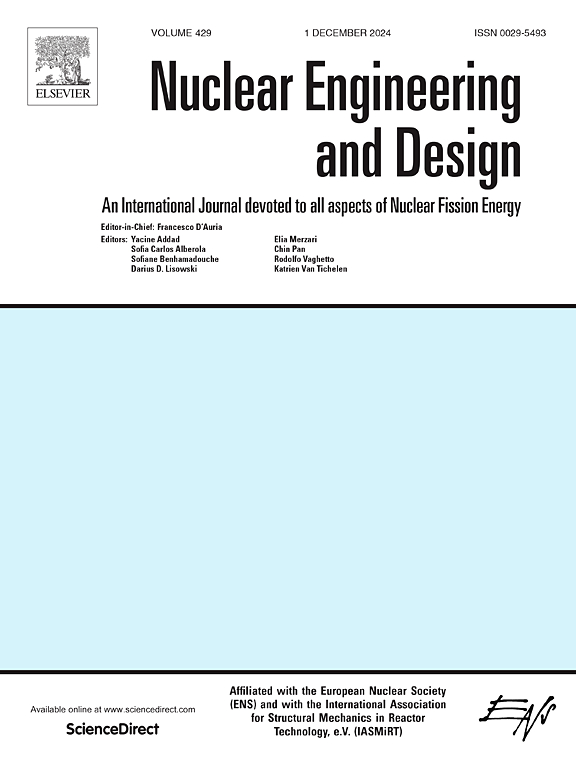开发BAEC 3MWt TRIGA mark-II研究堆的稳态单通道模型,用于热和水动力分析
IF 2.1
3区 工程技术
Q1 NUCLEAR SCIENCE & TECHNOLOGY
引用次数: 0
摘要
孟加拉国原子能委员会(BAEC)运营3mwt TRIGA MARK II研究堆(BTRR),这是孟加拉国唯一的研究堆,位于萨瓦尔的原子能研究机构(AERE)。自1986年投入使用以来,该反应堆发挥了多用途作用,包括培训、教育、放射性同位素生产,以及中子活化分析、中子散射和中子射线照相的各种研究活动。本研究的重点是BTRR堆芯单通道模型的开发和应用,提供了分析反应堆在强制对流和自然循环冷却两种运行模式下的稳态热学和流体动力行为的能力。采用蒙特卡罗中微子(OpenMC)与所建立的单通道模型之间的外部耦合迭代策略。耦合方法捕获了温度相关截面、控制棒位置和反应堆热行为之间的反馈,从而能够更准确地预测关键参数。该模型与McAdams等人、Bernath、Labuntsov、Mirshak等人、Lund和2006年Groeneveld查找表(LUT)开发的多重相关性一起使用,以确定运行条件下不同功率水平下最热通道的临界热流密度(CHF)和偏离核沸腾比(DNBR)。传统上用于TRIGA反应堆的Bernath相关性提供了保守的CHF估计,而2006年Groeneveld LUT提供了更高的安全边际。与其他相关性的比较突出了CHF预测的差异,强调需要使用多种相关性的综合方法来提高反应堆的性能和安全性。该分析显示了该模型与先前基于代码的计算的验证,并为预测临界热裕度提供了详细的见解,包括反应器的CHF和DNBR特性。开发的模型为安全性预测提供了基础,并强调了提高反应堆性能的潜力,包括未来对BTRR堆芯结构的升级。本文章由计算机程序翻译,如有差异,请以英文原文为准。
Development of a steady-state single-channel model of the BAEC 3MWt TRIGA mark-II research reactor for thermal and hydrodynamic analysis
The Bangladesh Atomic Energy Commission (BAEC) operates the 3 MWt TRIGA MARK II research reactor (BTRR), the only research reactor in Bangladesh, located at the Atomic Energy Research Establishment (AERE) in Savar. Since its commissioning in 1986, the reactor has served multipurpose roles, including training, education, radioisotope production, and various research activities in neutron activation analysis, neutron scattering, and neutron radiography. This study focuses on the development and application of a single-channel model for the BTRR core, providing the capability to analyze the steady-state thermal and hydrodynamic behavior of the reactor under both forced convection and natural circulation cooling modes of operation. An iterative strategy was adopted with external coupling between Monte Carlo neutronics (OpenMC) and the developed single-channel model. The coupled approach captures the feedback between temperature-dependent cross-sections, control rod position, and reactor thermal behavior, enabling more accurate predictions of critical parameters. The model is used with multiple correlations developed by McAdams et al., Bernath, Labuntsov, Mirshak et al., Lund, and the 2006 Groeneveld look-up table (LUT), to determine critical heat flux (CHF) and departure from nucleate boiling ratio (DNBR) for the hottest channel at different power levels under operational conditions. The Bernath correlation, traditionally used for TRIGA reactors, provided conservative CHF estimates, while the 2006 Groeneveld LUT offered higher safety margins. Comparisons with other correlations highlighted variations in CHF predictions, emphasizing the need for a comprehensive approach using multiple correlations to enhance reactor performance and safety. This analysis shows verification of the model against previous code-based calculations and provides detailed insights into predicting critical thermal margins, including CHF and DNBR characteristics of the reactor. The developed model provides a basis for safety predictions and highlights the potential for enhancing reactor performance, including future upgrades to the BTRR core configuration.
求助全文
通过发布文献求助,成功后即可免费获取论文全文。
去求助
来源期刊

Nuclear Engineering and Design
工程技术-核科学技术
CiteScore
3.40
自引率
11.80%
发文量
377
审稿时长
5 months
期刊介绍:
Nuclear Engineering and Design covers the wide range of disciplines involved in the engineering, design, safety and construction of nuclear fission reactors. The Editors welcome papers both on applied and innovative aspects and developments in nuclear science and technology.
Fundamentals of Reactor Design include:
• Thermal-Hydraulics and Core Physics
• Safety Analysis, Risk Assessment (PSA)
• Structural and Mechanical Engineering
• Materials Science
• Fuel Behavior and Design
• Structural Plant Design
• Engineering of Reactor Components
• Experiments
Aspects beyond fundamentals of Reactor Design covered:
• Accident Mitigation Measures
• Reactor Control Systems
• Licensing Issues
• Safeguard Engineering
• Economy of Plants
• Reprocessing / Waste Disposal
• Applications of Nuclear Energy
• Maintenance
• Decommissioning
Papers on new reactor ideas and developments (Generation IV reactors) such as inherently safe modular HTRs, High Performance LWRs/HWRs and LMFBs/GFR will be considered; Actinide Burners, Accelerator Driven Systems, Energy Amplifiers and other special designs of power and research reactors and their applications are also encouraged.
 求助内容:
求助内容: 应助结果提醒方式:
应助结果提醒方式:


